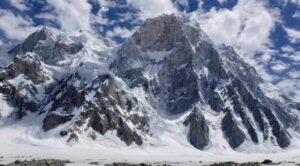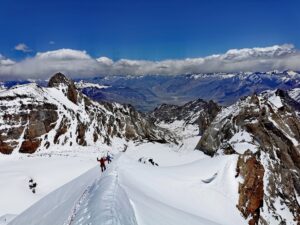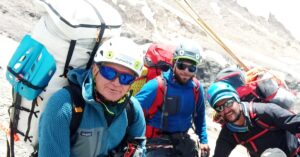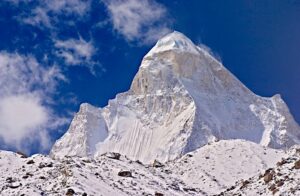On 8,000m peaks, the ultimate goal is to reach the summit, so obviously the easier the route, the better. That is, until Chris Bonington and his crew changed the game in 1970.
During the first half of the 20th century, achieving first ascents of the world’s highest peaks became a sort of national challenge. The French pioneers who first summited an 8,000’er had actually aimed for Dhaulagiri, but after weeks of searching fruitlessly for a viable route, they discarded the plan and moved to the nearest peak above 8,000m. The result was their historical success on Annapurna. The other 13 Himalayan giants were “conquered” in a similar way, using all the resources available at the time and the safest possible routes.

Chris Bonington in the 1970s.
Then came a new generation of climbers, trained on vertical rock, motivated by difficulty rather than altitude, who eventually took their ideas to the Himalaya. One of them, Chris Bonington, saw the perfect objective on Annapurna, when he stood before its 3,000m South Face for the first time. It was a sheer wall of frozen, rocky spurs, hanging seracs, and ice gullies.
What climbers a few years earlier would have dismissed as the wrong side of the mountain now became a new way to understand high-altitude alpinism. You climb not because it’s there, but because it’s difficult.
The trick was applying big-wall rock climbing techniques on a Himalayan scale. Win metre after metre from the void, with ropes, jumars, and patience. It was not (yet) about doing so in a pure, minimalist style.

Bonington assembled the big team from his regular climbing pals: Nick Estcourt, Martin Boysen, Ian Clough, Mike Thompson, Mick Burke, and the already famous Dougal Haston, but the project soon grew bigger than expected: A film crew would accompany the expedition and send footage back to London (via runner to Pokhara, by road to Kathmandu, then by plane) every week for Thames Television.
Sponsors suggested that a book should be written afterwards. To increase sales, they advised including an American on the team, which is how Tom Frost, seasoned in Yosemite, came to join. Don Whillans’ extensive Himalayan experience also earned him a place, despite conflicts with the leader and poor fitness from too much eating, smoking, and drinking. There was even a BC manager and team doctor.
The logistics were complicated: Nepal had just reopened to foreigners after some years of closure for political reasons. Most loads were shipped to Mumbai, while the climbers and Sherpas trekked from Pokhara, a hippie haven at the time. By the end of March, the team finally established Base Camp and eyed a possible route up the face. They had two months to complete their climb before the monsoon hit. An eight-man Sherpa team would help. The lead climbers would use O2 for the final summit push. Or so they thought.

In that era of siege-style expeditions, they fixed ropes along almost the entire route and set six higher camps along a spur leading to the summit. The line was aesthetic, direct, and brutally hard.
The terrain ranged from rocky outcrops to soft snow slogs, vertical ice cliffs to sharp ridges. One serac that overhung the lower part of the route was so threatening that they dubbed it the Sword of Damocles. The higher they went, the harder the climbing, and the slower the pace. By the time Frost and Burke set up Camp V (on May 8), the rest of the team was too sick and too tired to supply them with enough food, gasoline, or O2.
Pairs of climbers took shifts, but over the weeks, some of them became so gassed by the relentless work that they couldn’t continue. There was supposed to be a Camp VII, but they lacked the manpower to carry up tents or supplies. Camp VI was bad enough, set on a tiny ledge. There was no way to supply the lead climbers, Whillans and Haston, with supplementary O2 or even food for more than 24 hours at a time.
To make matters worse, a terrible snowstorm hit on May 25 and lasted two days. But then the weather improved on the 27th, and the two men started off, without supplementary O2. Setting no belays on the ice pitches, they reached the summit by 2 pm. Three hours later, they were back in Camp VI.
Burke and Frost made their own summit bid two days later but turned back above Camp VI. One by one, the camps were dismantled, and everyone made it safely down –- until the very last day. The Sword of Damocles shed a chunk of ice, which triggered an avalanche that killed Ian Clough. They recovered his body and buried it at the foot of the mountain.
The story is worth a movie, and it was indeed turned into a documentary. Most of all, Bonington’s Annapurna South Face became a classic of climbing literature and inspired a whole generation to dream of grand vertical adventures. For a shorter version, here is the report Chris Bonington wrote for the Alpine Journal shortly after his return.
Their bold ascent of Annapurna’s South Face changed the course of Himalayan climbing. The era of first ascents was over, but Bonington and company opened up a new gate of extremely difficult high-altitude routes. This philosophy continues today and sets the standard for excellence in alpinism. Since then, the mighty Annapurna face has attracted the best, from duos MacIntyre and Ghilin and Bohigas and Lucas in the 1980s to Ueli Steck in the new century.
On their return, most of the British climbers on the expedition gained fame as a new kind of idol — part athlete, part adventurer, part madman.






